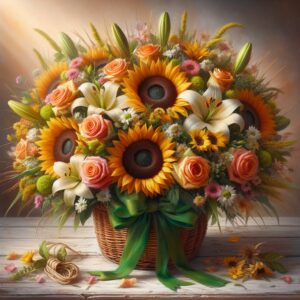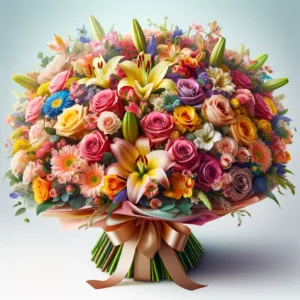Discover the elegance of European Designs bouquets, where artistry meets floral perfection. Explore a curated collection of exquisite arrangements that embody the timeless beauty and sophisticated charm of European floral art.
Introduction
The allure of European Designs bouquets lies in their unparalleled elegance and sophisticated charm, drawing inspiration from the rich tapestry of European art, culture, and natural beauty. These bouquets are more than just floral arrangements; they are a celebration of the continent’s diverse floral traditions, blending the romanticism of Parisian floristry with the rustic beauty of the Mediterranean and the structured, yet whimsical arrangements found in English gardens.
European Designs bouquets are meticulously crafted, emphasizing balance, color, and texture to create compositions that evoke emotions and tell stories. Each bouquet is a testament to the artistry of European floral design, making them the perfect choice for those seeking to add a touch of elegance and timeless beauty to their special occasions or everyday spaces. Whether it’s to convey love, celebrate a milestone, or simply to bring a piece of European elegance into one’s home, a European Designs bouquet is a choice par excellence.
Table of contents
European Designs bouquet
Imagine a bouquet that encapsulates the essence of European elegance and charm. This bouquet is a harmonious blend of traditional beauty and contemporary sophistication, featuring a selection of flowers that are both classic and modern. The focal point of this bouquet could be luxurious roses, known for their timeless appeal, surrounded by delicate peonies and fragrant lilies, which add a touch of romantic allure. To introduce a modern twist, exotic orchids might be interwoven, bringing an element of surprise and exotic beauty.
The color palette of this bouquet is soft and sophisticated, with pastel hues of pink, lavender, and white dominating, accented by deeper tones of purple or blue for depth and contrast. This combination not only appeals to the senses but also evokes a sense of calm and tranquility.
Greenery plays a crucial role in this bouquet, with lush foliage and unique textures provided by ferns or eucalyptus, adding to the bouquet’s overall volume and enhancing its natural beauty. The arrangement is thoughtfully designed to ensure that each flower and leaf complements the others, creating a cohesive and visually stunning masterpiece.
Wrapped elegantly in a simple yet chic wrapping, such as natural burlap or a soft, textured fabric, tied with a ribbon, this bouquet represents the blend of tradition and innovation that is characteristic of European design. It’s perfect for any occasion, from weddings and anniversaries to a simple gesture of love or appreciation, embodying the sophistication and refined beauty that European designs are known for.
Elements of European Design Bouquets
European design bouquets are a testament to the continent’s rich floral artistry tradition, blending elegance, balance, and a deep appreciation for nature’s beauty. These bouquets are not just arrangements of flowers; they are carefully crafted pieces of art that reflect a deep understanding of design principles, cultural influences, and innovative approaches to floral arrangement. Here are some key elements that typify European design bouquets:
1. Use of Color
European design bouquets often feature a sophisticated color palette that may range from soft, pastel hues to bold, contrasting colors. The choice of color is deliberate, aiming to evoke specific emotions, complement the flowers’ natural beauty, or reflect seasonal changes.
2. Variety and Texture
Texture plays a crucial role in European floral designs. These bouquets skillfully combine a variety of flowers and foliage to create depth, interest, and a dynamic appearance. The juxtaposition of different textures—such as the softness of petals against the roughness of bark or the smoothness of leaves—adds a tactile dimension to the visual appeal.
3. Shape and Structure
European bouquets are known for their structured yet natural-looking arrangements. They often follow geometric shapes—circular, triangular, or linear—while still appearing effortlessly graceful. The structure is achieved through careful placement and balancing of elements, ensuring that the bouquet looks stunning from every angle.
4. Focal Points and Rhythm
Creating a focal point is essential in European design bouquets. This is often achieved by using larger or more vibrant flowers at the center or strategically placing unique elements to draw the eye. The arrangement is designed to lead the viewer’s gaze through the bouquet, creating a sense of rhythm and movement.
5. Harmony and Contrast
European designs seek to balance harmony and contrast. This involves coordinating colors, textures, and shapes in a way that they complement each other, while also introducing elements that stand out for visual interest. This delicate balance ensures that the bouquet is cohesive yet dynamic.
6. Innovation and Tradition
European floral designs are deeply rooted in history and tradition, drawing on centuries-old techniques and styles. However, European florists are also at the forefront of innovation, experimenting with new materials, techniques, and concepts to push the boundaries of traditional floral design.
7. Symbolism and Meaning
Flowers hold different meanings and symbolism across European cultures, and these bouquets often incorporate elements that convey specific messages or sentiments. Whether it’s love, remembrance, or celebration, European design bouquets use the language of flowers to express complex emotions and stories.
8. Attention to Detail
Every element of a European design bouquet is chosen and placed with precision and care. From the selection of the flowers to the wrapping of the stem, attention to detail is paramount, ensuring that the final product is not just beautiful but also of the highest quality.
DIY European Bouquet Projects
Creating your own DIY European bouquet can be a rewarding project that not only brings the beauty of European floral design into your home but also allows for a personal touch that can’t be replicated by store-bought arrangements. European bouquets are distinguished by their elegance, diversity, and intricate arrangement styles. Here’s how you can embark on DIY European bouquet projects, blending creativity with the classic charm of European floral artistry.

1. Gather Your Materials
- Flowers and Foliage: Select a variety of flowers and foliage that offer different textures, sizes, and colors. European bouquets often feature a mix of statement flowers (like roses, peonies, or hydrangeas) with filler flowers (such as baby’s breath or aster) and foliage (like eucalyptus or ferns) for depth and texture.
- Floral Supplies: You’ll need a floral foam or a vase, floral tape, and scissors or floral shears. For a more traditional European touch, consider using a floral frog to hold stems in place.
- Wrapping Materials: For a finished look, have some wrapping paper, burlap, or fabric on hand, along with ribbon or twine.
2. Choose Your Color Scheme and Theme
Decide on a color palette that suits your taste or the occasion. European bouquets often utilize soft pastels, rich jewel tones, or classic white and green combinations. The theme could be anything from a rustic country look to a more formal, elegant arrangement.
3. Prepare Your Flowers
Trim the stems at an angle under running water to ensure they can absorb water more efficiently. Remove any leaves that will be below the waterline to prevent bacterial growth.
4. Create a Foundation
Start by creating a base with your foliage to establish the shape and structure of the bouquet. European designs often have a natural, yet sophisticated structure. Use your larger foliage pieces to create a framework.
5. Add Focal Flowers
Insert your focal flowers, considering balance and proportion. These should be the stars of your bouquet, so place them where they’ll have the most impact, often near the center or slightly off-center for a more dynamic look.
6. Incorporate Filler Flowers and Additional Texture
Add filler flowers and additional elements of texture to fill in gaps and add complexity to the arrangement. This step brings the bouquet to life, adding layers and visual interest.
7. Evaluate and Adjust
Step back and look at your bouquet from various angles. Adjust as needed to ensure the bouquet is balanced and cohesive. European bouquets are admired for their symmetry and proportion, so make sure your arrangement has a harmonious flow.
8. Wrap Your Bouquet
For a true European flair, wrap your bouquet in stylish paper, burlap, or fabric, securing it with ribbon or twine. This not only adds to the aesthetic but also makes the bouquet easier to handle or gift.
9. Care and Placement
Place your bouquet in a vase with fresh water and a flower preservative to extend its life. Choose a spot in your home where it can be admired, avoiding direct sunlight or drafts.
Tips for Success:
- Experiment with different flowers and arrangements to find what you love.
- Consider the symbolism of flowers in European cultures to add meaning to your bouquet.
- Take care of your flowers by changing the water regularly and trimming the stems every few days.
DIY European bouquet projects allow you to explore your creativity while paying homage to the sophisticated and varied styles of European floral design. Whether you’re crafting a simple arrangement for your dining table or a lavish bouquet for a special occasion, the process itself is sure to bring joy and beauty into your life.
European Bouquets in Interior Design
European bouquets play a transformative role in interior design, blending the timeless elegance of European floral artistry with contemporary living spaces. These bouquets are not just floral arrangements; they are a sophisticated blend of design principles that add color, texture, and life to any room. Incorporating European bouquets into interior design can elevate the aesthetics of a space, bringing in a touch of nature’s beauty and a sense of refined grace. Here’s how European bouquets can be effectively used in interior design:
1. Accentuating Color Schemes
European bouquets can be designed to complement or accentuate the existing color schemes of a room. Whether it’s a soft, pastel-hued arrangement that adds a subtle touch of color or a vibrant, contrasting bouquet that serves as a focal point, these floral arrangements can enhance the overall color palette of an interior space.
2. Adding Textural Contrast
The varied textures found in European bouquets—from the smooth, delicate petals of roses to the rough, rustic feel of branches and foliage—can add a dynamic layer of textural contrast to interior spaces. This contrast is key in creating visually interesting and balanced rooms, adding depth and character to sleek, modern designs or warmth to minimalist aesthetics.
3. Creating Focal Points
A well-placed European bouquet can serve as a stunning focal point in a room, drawing the eye and anchoring the space. Whether it’s a large, dramatic arrangement on a dining table or a small, intricate bouquet on a coffee table, these floral designs can command attention and direct the flow of the room.
4. Enhancing Spatial Perception
European bouquets can also influence the perception of space within a room. Larger arrangements can make a spacious room feel more intimate and cozy, while smaller bouquets can add a sense of delicacy and openness to compact spaces. The strategic placement of floral arrangements can alter how a room feels, making it more welcoming and harmonious.
5. Bringing in Seasonal Elements
Incorporating seasonal European bouquets into interior design allows for the space to remain dynamic and connected to the natural world. Spring arrangements with tulips and daffodils, summer bouquets with peonies and hydrangeas, autumn designs featuring chrysanthemums and berries, and winter compositions with evergreens and holly can all bring the essence of each season indoors.
6. Promoting Well-being
Beyond aesthetics, European bouquets can enhance the well-being of inhabitants by bringing a piece of nature indoors. The presence of flowers and plants in living spaces has been shown to reduce stress, improve mood, and purify the air, contributing to a healthier and more pleasant living environment.
7. Reflecting Personal Style
European bouquets offer endless possibilities for personalization, allowing individuals to reflect their personal style and preferences through the choice of flowers, colors, and arrangements. This personal touch adds a unique character to the interior design, making the space truly feel like home.
Practical Tips for Incorporating European Bouquets:
- Consider Scale: Ensure the size of the bouquet complements the room and furniture it accompanies.
- Play with Placement: Experiment with different locations to find where the bouquet makes the most impact.
- Maintain Freshness: Regularly change the water and trim the stems to keep the flowers looking their best.
FAQ’s
European floral designs are characterized by their focus on simplicity, elegance, and balance. These arrangements typically feature symmetrical designs with multiple focal flowers, where every component is meticulously selected to complement and elevate the entire composition.
This distinctive bouquet boasts a round, compact style, marked by intricately crisscrossed stems. This careful arrangement enables the bouquet to stand independently once it is tied.
The French technique of bouquet creation is renowned for its classic simplicity and minimal complexity. The secret lies in the wrist action. Begin by securing the initial three or four flowers between your thumb and index finger, then twirl! Continue to introduce more flowers as desired, ensuring balance is maintained on both sides.
The English Garden Bouquet features a delightful blend of fresh flowers arranged within a square glass cylinder. This assortment includes hydrangeas, stock, roses, and spray roses. While the colors may vary based on the current selection available, this stunning floral arrangement is guaranteed to delight any recipient.
Currently, five historical European periods: Renaissance, Baroque, Rococo, Georgian, and Victorian, remain significant influencers on contemporary floral styling trends for weddings.
Conclusion
European design bouquets stand as a testament to the rich heritage and refined aesthetics of floral art across Europe. These arrangements, characterized by their elegance, balance, and intricate detailing, encapsulate the essence of European artistry. Drawing inspiration from historical eras such as the Renaissance, Baroque, Rococo, Georgian, and Victorian periods, European bouquets continue to influence modern floral designs, particularly in settings as special as weddings.
Their ability to blend traditional techniques with contemporary trends ensures that European-designed bouquets remain a popular choice for those seeking to add a touch of sophistication and natural beauty to their surroundings. Whether through the careful selection of colors, the strategic placement of focal flowers, or the harmonious balance of textures and shapes, European design bouquets celebrate the timeless allure of nature’s offerings, making them an enduring favorite in the world of floral design.







